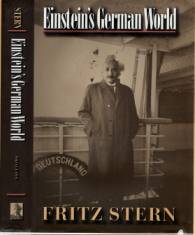 The
Chemical Educator, Vol. 5,
No. 4, S1430-4171(00)04408-1, 10.1007/s008970408a, © 2000 Springer-Verlag
New York, Inc.
The
Chemical Educator, Vol. 5,
No. 4, S1430-4171(00)04408-1, 10.1007/s008970408a, © 2000 Springer-Verlag
New York, Inc.
Einstein’s German World. Fritz Stern. ix + 335 pp. Princeton University Press: Princeton, NJ, 1999. $24.95; £15.95.ISBN 0-691-05939-X.
Reviewed by George B. Kauffman, California State University Fresno, george_kauffman@csufresno.edu

While walking with Fritz Stern to a West Berlin exhibit in April 1979 commemorating the centenary of the births of Einstein, Max von Laue, Otto Hahn, and Lise Meitner, French political philosopher Raymond Aron remarked that the twentieth century “could have been Germany’s century.” By 1900 the Reich was Europe’s pre-eminent power with a vital culture, unrivaled educational system, authoritarian academic–industrial–military complex, and extraordinary scientific accomplishments. The country was poised to achieve true greatness, but its prospects went unfulfilled, culminating in two world wars and the Holocaust.
In this collection of invited lectures and essays, previously published in German or English but revised in the light of new archival materials from Germany, the United States, Israel, and Switzerland, and updated with references as late as 1998, Fritz Stern, University Professor Emeritus at Columbia University, a prize-winning historian and the author of a number of books on the history of modern Europe, explores the ambiguous promise of Germany before Hitler, its appalling decline into moral nihilism during the Nazi régime, and aspects of its remarkable recovery since World War II.
Stern is eminently qualified both by personal circumstances and interest to undertake this balanced and insightful blend of history and biography that critically analyzes some of Germany’s greatest Jewish scientists as well as German–Jewish relations and anti-Semitism during this period. Nobel chemistry laureate Fritz Haber was his godfather and a longtime friend of his parents. A member of the Editorial and Executive Committees of The Collected Papers of Albert Einstein since 1984 and a nephew of physicist Otto Stern, he met Einstein, Chaim Weizmann, and other prominent scientists profiled in the book and had unlimited access to family correspondence, privately held papers, and personal recollections. His father, Rudolf, was Haber’s physician, worked at Haber’s Kaiser Wilhelm Institute for Physical Chemistry (1921–1923), wrote an article on Haber, attended Mrs. Weizmann as a doctor, and was acquainted with Haber’s closest friend, Richard Willstätter, as well as Weizmann, and other scientists and public figures. Stern’s mother dedicated two of her books to Haber.
The central essay and longest of the book’s nine chapters, “Together and Apart: Fritz Haber and Albert Einstein,” occupies 106 pages, almost one-third of the volume. It explores their public and personal lives, notes their similarities, and contrasts their different responses to German life and their Jewish heritage. Haber, a convert to Christianity, developed the process for the fixation of atmospheric nitrogen, which was a prime example of German economic and industrial triumph and the source of munitions and fertilizers that allowed Germany to continue the war beyond the spring of 1915. Haber’s introduction of poison gas into warfare earned him the revulsion of the civilized world, yet he was a fervent German patriot until the advent of the Nazis to power. Einstein, on the other hand, was an internationalist, a pacifist, and a proud although secular Jew.
Other prominent figures profiled include Paul Ehrlich, the founder of chemotherapy; physicist Max Planck, “the first servant of German science,” who, although not Jewish, protested the anti-Semitic campaign waged against Einstein and others; Walther Rathenau, the ambivalent and conflicted industrialist and statesman who was assassinated in 1922; and Russian-born Chaim Weizmann, chemist, committed Zionist, and first president of Israel. Stern also examines the still-controversial manner in which both German and non-German historians have dealt with World War I. He considers also how Germans have dealt with their country’s defeat, persistent conflicts over interpretations of Germany’s past, the psychological cost of East and West Germany’s reunification and the country’s current challenges and future prospects, as well as the reconciliation between Germany and Poland (Stern was born in Breslau, Germany, now Wroclaw, Poland). It is unfortunate that no portraits of the many scientific luminaries dealt with in this book are included, but this would probably have added to its modest price.
This book is much more than academic history. It is a cautionary tale. My former wife’s family delayed fleeing Germany until virtually the last moment (1939), blinded to reality by rationalizations: “This is Germany, the land of Beethoven and Goethe, the most civilized country in the world.” According to Stern, “No country, no society, is shielded from the evils that the passivity of decent citizens can bring about. That is a German lesson of the twentieth century—for all of us.”